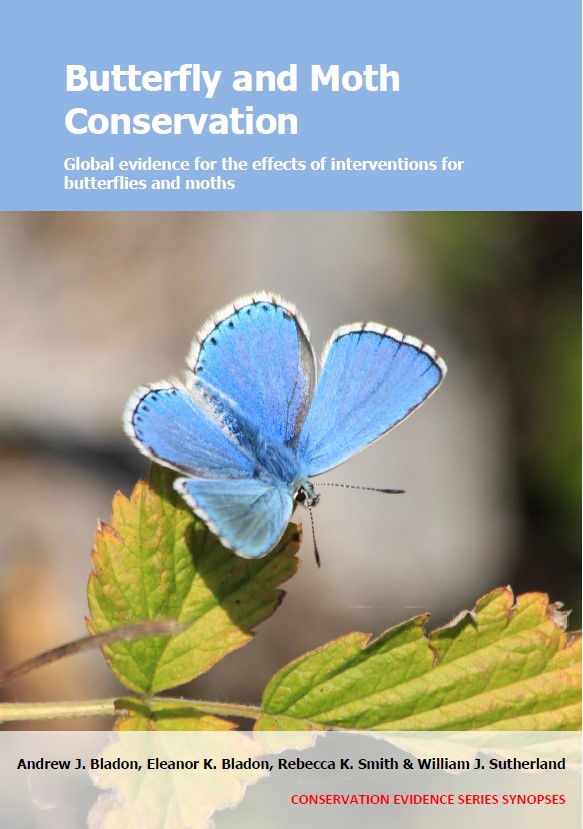Actions to conserve biodiversity
We have summarised evidence from the scientific literature about the effects of actions to conserve wildlife and ecosystems.
Review the evidence from the studies
Not sure what Actions are? Read a brief description.
Search for evidence
e.g. "frogs chytrid"
152 Actions found
Refine
Hide
152 Actions found
Download Actions
| 0 selected |
|
Order results by:
| Action | Effectiveness | Studies | Category | |
|---|---|---|---|---|
|
Mechanically remove mid-storey or ground vegetation to create fire breaks Action Link |
Awaiting assessment | 2 |
|
|
|
Use prescribed fire to maintain or restore disturbance in grasslands or other open habitats Action Link |
Evidence not assessed | 13 |
|
|
|
Use rotational burning Action Link |
Evidence not assessed | 17 |
|
|
|
Remove or control non-native predators Action Link |
No evidence found (no assessment) | 0 |
|
|
|
Remove, control or exclude invertebrate herbivores Action Link |
Evidence not assessed | 1 |
|
|
|
Replant alternative host plants or disease resistant individuals to combat losses to disease Action Link |
No evidence found (no assessment) | 0 |
|
|
|
Increase biosecurity checks Action Link |
No evidence found (no assessment) | 0 |
|
|
|
Restrict the sale of problem species in garden centres and pet shops Action Link |
No evidence found (no assessment) | 0 |
|
|
|
Remove, control or exclude native predators Action Link |
Evidence not assessed | 5 |
|
|
|
Remove or control non-native or problematic plants Action Link |
Evidence not assessed | 9 |
|
|
|
Remove, control or exclude vertebrate herbivores Action Link |
Awaiting assessment | 10 |
|
|
|
Introduce legislation to control the use of hazardous substances Action Link |
No evidence found (no assessment) | 0 |
|
|
|
Use fencing to reduce pesticide and nutrient run-off into margins, waterways and ponds Action Link |
No evidence found (no assessment) | 0 |
|
|
|
Provide buffer strips to reduce pesticide and nutrient run-off into margins, waterways and ponds Action Link |
Awaiting assessment | 1 |
|
|
|
Use genetically modified crops which produce pesticide to replace conventional pesticide application Action Link |
Awaiting assessment | 1 |
|
|
|
Restrict certain pesticides or other agricultural chemicals Action Link |
Awaiting assessment | 5 |
|
|
|
Reduce fertilizer, pesticide or herbicide use generally Action Link |
Evidence not assessed | 11 |
|
|
|
Leave headlands in fields unsprayed (conservation headlands) Action Link |
Awaiting assessment | 6 |
|
|
|
Stop using herbicides on pavements and road verges Action Link |
Awaiting assessment | 2 |
|
|
|
Stop using pesticides as seed dressings and sprays in flower beds and greenspace Action Link |
Evidence not assessed | 1 |
|
|
|
Restrict timing of lighting to conserve areas with natural light regimes Action Link |
No evidence found (no assessment) | 0 |
|
|
|
Use low intensity lighting Action Link |
Awaiting assessment | 1 |
|
|
|
Restrict use of polarized light Action Link |
No evidence found (no assessment) | 0 |
|
|
|
Use shielded “full cut-off” lights to remove outwards lighting Action Link |
Awaiting assessment | 1 |
|
|
|
Use glazing treatments to reduce light spill from inside lit buildings Action Link |
No evidence found (no assessment) | 0 |
|
Download Actions
| 0 selected |
|

Butterfly and Moth Conservation - Published 2023
Butterfly and Moth Synopsis
Watch this search
If you are familiar with RSS feeds, please click the button below to retrieve the feed URL:
RSS feed for this searchIf you are unfamiliar with RSS feeds, we would suggest reading this BBC article.
Unfortunately, due to the number of feeds we have available, we cannot provide e-mail updates. However, you could use tools such as Feed My Inbox to do this for you.
What are 'Individual studies' and 'Actions'?
Individual studies
An individual study is a summary of a specific scientific study, usually taken from a scientific journal, but also from other resources such as reports. It tells you the background context, the action(s) taken and their consequences.
If you want more detail please look at the original reference.
Actions
Each action page focuses on a particular action you could take to benefit wildlife or ecosystems.
It contains brief (150-200 word) descriptions of relevant studies (context, action(s) taken and their consequences) and one or more key messages.
Key messages show the extent and main conclusions of the available evidence. Using links within key messages, you can look at the paragraphs describing each study to get more detail. Each paragraph allows you to assess the quality of the evidence and how relevant it is to your situation.
Where we found no evidence, we have been unable to assess whether or not an intervention is effective or has any harmful impacts.





)_2023.JPG)














